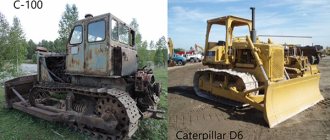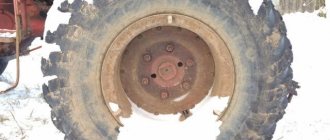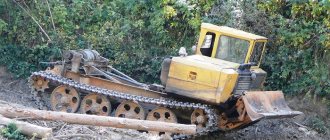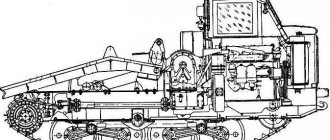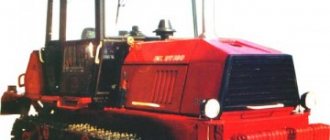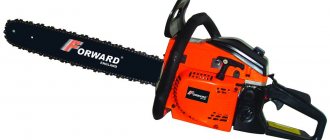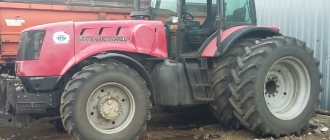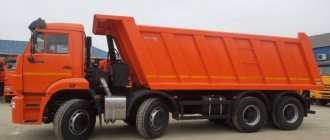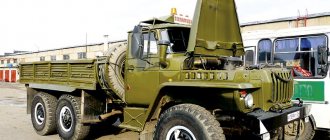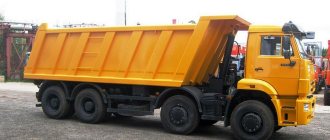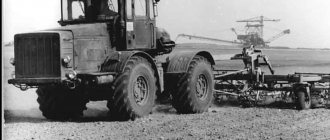The TT 4 tractor is a tracked skidding machine that began to be produced at ATZ after 1970. The TT 4 skidder transports timber of impressive size, and it also performs large-batch loading of timber onto platforms or rolling stock. Most often it is required for transporting trees from forest land to specially prepared warehouses. Thanks to the caterpillar track, the loaded TT 4 skidder will even pass through swampy surfaces. the TDT-75 tractor ; the designer updated the engine model by installing a stronger and more economical engine. When developing the frame, it was decided to make the bottom closed. This solution protects the structure from mechanical damage when moving through the forest, where snags and stones are scattered on the ground.
Skidder TT 4
Review
The TT-4 skidding tractor is a Soviet tracked tractor of IV traction class, produced by the Altai Tractor Plant. It first rolled off the conveyor belt in 1969. For forty years the plant produced similar equipment. Many modifications have been created based on the basic version. Production ended in 2010. It received wide publicity for its reliability and power. Therefore, after the closure of the ATZ, other factories began to produce it in small quantities.
Purpose
The TT-4 tractor and its modifications are used to move large and medium-sized timber to warehouses and intermediate storage areas, as well as to load material onto timber trucks and all kinds of platforms. In addition, various forestry equipment can be attached to it as a trailer. Its unpretentiousness and ability to perform its task in the harshest climatic conditions made the machine indispensable for the northern regions.
By the way, the TT-4M-01 tractor was produced without working equipment and was a chassis on which it was possible to assemble various types of special equipment (drilling and crane, delimbing machines, mobile welding, forestry and other units). This and other modifications will be discussed in more detail below.
Advantages and disadvantages
The creators of this unit relied on versatility and operational reliability. Logging requires special equipment that is designed for heavy loads and has a good margin of safety. Like any other machine, the TT-4 skidder has its pros and cons.
Advantages
- Wide tracks provide good maneuverability in any terrain and weather conditions. Forests littered with windbreaks, swampy and difficult to pass places - there are no obstacles that interfere with the movement of equipment.
- The diesel engine not only has sufficient power, but also low fuel consumption.
- TT-4 is built on a universal base. Thanks to this, many modifications were created.
- Large ground clearance allows the car to easily move through difficult terrain without bumping into small bumps and stones.
- High traction force, a durable frame and underbody protection ensure reliability and increase service life.
Flaws
- The engine, located literally under the front seat, greatly reduces comfort.
- Large dimensions and heavy weight make the tractor less maneuverable than its “brothers”. For example, comparing it with the same TDT-55.
- Like other tracked models, the movement speed is insignificant. This drawback is partially corrected by a slight pressure on the ground of 44.13 kPa.
Owner reviews
Nikolay, 48 years old:
“It’s a durable tractor, excellent cross-country ability - it can easily pass through a swamp, in the snow, and everywhere. For logging - indispensable, performs a lot of work, control is very simple, minimum electronics, maximum mechanics - can be repaired without problems."
Peter, 52 years old:
“I bought a skidder 8 years ago for my company. The tractor was shabby, there were some problems, but it was cheaper to buy a broken unit at a reasonable price and repair it than to buy a new one. The machine was used both in construction and logging, survived two more serious breakdowns, but is still in working order. There are no complaints about the tractor, it’s worth the price.”
Specifications
The machine has the most optimal characteristics that fully meet the requirements of its field of activity. All information described is relevant only for the basic version. Components of different modifications may differ greatly from the initial version.
Engine
The initial version is equipped with an A-01ML with six cylinders, a power of 81 kW (about 110 hp) and the presence of SNVT. The motor operates at a frequency of 1600 rpm. Passive cooling is used to reduce engine temperature. To clean the incoming air, five filters are installed: 2 air and 3 fuel.
The engine is started using a gas starter equipped with an electric starter (ST-350). Power comes from the battery. In extreme cold, the PZh-300 liquid heater is also used to start the engine.
The tank capacity is 135 liters. Fuel consumption for this type of equipment is average – 250 g/kWh
The motor, located literally under the seat, greatly reduces overall comfort, but allows for increased visibility and a slight reduction in overall dimensions and weight.
Frame
The skidder is based on a durable frame. The basis is a pair of spars connected by metal tubes by welding. To increase strength, fenders and a bumper are placed on top of the frame. The composition includes special flaps with hinged-bolt fastening under the engine. They are attracted to the bottom, providing additional protection.
Transmission
The skidding machine is equipped with a 4-speed gear manual transmission. There are 8 forward speeds and 4 reverse. The main gear contains 2 bevel gears with spiral-shaped teeth. The rotating mechanism is planetary, with pedal activation. The planetary system brakes are activated by two levers, with a hydraulic booster installed. The equipment has band-type brakes, also with a hydraulic component.
Chassis
This model of the unit is equipped with a semi-rigid type balancer-lever suspension. It has 2 rear and 2 front carriages. On one side of each there are 5 solid single-row rollers. Two rollers are connected to the front carriage, and three to the rear. Track tension occurs due to a crank-screw mechanism equipped with rigid springs.
Device
Engine
The engine on the skidder is a diesel engine, four-stroke type, with six cylinders arranged vertically in one row. Cooling occurs using liquid. Fuel is injected directly, and lubricant is applied twice: under pressure and by spraying. The starting motor is equipped with an electric starter. For winter conditions, a heater is used. A double purification system is used for exhaust air, and a triple purification system for fuel.
This is a welded structure, consisting of spars connected by pipes, on which bumpers with wings are attached. The frame also includes angles with a frontal sheet and bottom flaps. These flaps under the motor are hinged. To close them, you need to tighten the bolts, thereby pulling the bottom to the base of the frame.
Transmission
A dry clutch, the clutch of which has two discs, is closed all the time. The clutch is controlled by a hydraulically assisted pedal. The four-stage gear-type manual transmission provides eight forward speeds and four in the reverse direction. The main gear is based on two bevel gears with spiral teeth.
Chassis
A semi-rigid type balance-lever suspension is used. It has four carriages (two rear and two sprung front). On each side there are five cast single-row type rollers. Two rollers belong to the front carriage, three – to the rear. The track tensioning mechanism is a crank-screw, equipped with a shock absorber with springs.
Working equipment
At the rear of the frame, on the side members, there is a loading platform powered by a hydraulic drive, as well as a winch consisting of a gearbox and a drum on which the cable is wound. A mechanical transfer case with two speeds and reverse is mounted on the gearbox. An overrunning brake allows you to slow down the movement of the winch drum.
TT-4 tractor winch diagram
The welded loading panel has a wooden layer between steel sheets. There are rubber buffers in front, and the guide mechanism moves on bearings. The shield is dropped from the frame by a hydraulic drive and is also held in this state while the barrels are laid on it. The drive also lowers the loaded shield back onto the frame and raises the empty shield for transportation.
Cabin
The cabin has two seats, which are located on the left hand side of the engine. The driver's seat is adjustable using a hydraulic shock absorber. On the front wall there is an instrument panel, and next to it there is a device for opening the radiator curtains. On the back wall there is a winch control lever.
Working equipment
The loading platform and winch are located on the rear side member. Control occurs using a hydraulic drive. The winch consists of a drum on which the cable is placed and a gearbox. The latter is equipped with a two-speed manual transmission with reverse gear. The movement of the winch drum is controlled using a brake with an overrun clutch. The equipment is equipped with two winches with traction forces of 9 and 12 tons, respectively.
The loading shield is made of a pair of steel sheets, between which a layer of wood is fixed. The maximum load on it is 6 tons. Rubber buffers are located at the front, and the guide mechanism operates on bearings.
The hydraulic drive lowers the loading platform from the frame and holds it during loading, and raises it loaded or empty for transport work.
Cabin
This special equipment has a two-seater cabin. The seats are located on hydraulic shock absorbers on the left side of the engine. The instrument panel is located at the front, and the winch control lever is located on the rear wall of the cabin.
The salon has everything necessary for work in various climatic conditions. There is automatic ventilation and an electric stove to maintain optimal temperature during the cold season. In addition, there was space in the cabin for a first aid kit and a thermos. A sun visor is installed on the top of the windshield. There are power windows and windshield wipers.
The inside of the cabin is lined with vinyl leatherette, covered with polyurethane foam. This material has the ability to absorb sound and vibration, thereby making the operator’s work more comfortable. The floor has bitumen and leatherette pads. For convenience, rubber mats are also provided. The total weight of the vehicle is 12.8 tons.
Transmission
The clutch mounted on the A-03 ML diesel engine is friction, permanently closed, double-disc. It is located on the diesel flywheel and is closed with a lid. Torque from the flywheel to the shaft is transmitted due to frictional forces when the disks are compressed by springs, which, when the clutch is disengaged, provide a uniform gap between the disks.
The TT-4M transmission system includes a cardan drive and a transmission unit, which consists of a gearbox with a reverse gearbox, a rear axle and final drives. A power take-off shaft can be installed in the rear axle, driven by the intermediate shaft of the reverse gearbox. Cardan transmissions consist of 2 tubular shafts, with cardan joints, on needle bearings.
The gearbox is mechanical, four-speed, with movable gears, with a reverse gearbox. This gearbox provides eight forward gears and four reverse gears, and also has a gear shift locking mechanism.
The main gear is a pair of bevel gears with spiral teeth. The turning mechanism is a dual planetary, single-stage, with dry band brakes, two planetary and two stopping. The final drive is a pair of cylindrical gears with straight teeth.
Overview of modifications
TT-4 has many modifications. Over the entire existence of the basic version, various models have been created, with modified characteristics and additional equipment. Let's look at some of them.
TT-4M - this model is capable of operating at low temperatures characteristic of the harsh weather of the northern regions. This model overcomes obstacles with a slope of 25º, and the increased ground clearance is able to overcome obstacles up to 0.6 m in height.
The single-seat cabin and engine are front-mounted. This provides a good overview and the ability to install additional technical equipment. The suspension is the same as the classic model.
There are two types of transmission: conventional mechanics and hydraulics.
Characteristics of the modification.
- The power unit is A-01MRSI, reaching 130 hp.
- Total weight – 14.4 tons.
- Ground pressure – 38 kPa.
- Length – 6.07 m.
TT-4M-01 – this version is characterized by the absence of a drum winch and platform. It serves as a chassis for assembling various special equipment.
The differences are as follows:
- ground pressure – 33 kPa;
- total weight - 12.6 tons;
- load capacity – 113.5 kN;
- length – 5.92 m.
TT-4M-04 – a hydraulically driven pusher is already installed here. This device made it easier to perform basic tasks during logging.
Modification characteristics.
- Weight with equipment – 14.945 tons.
- Load capacity – 113.5 kN.
- Soil pressure – 39 kPa.
- Length – 7.03 m.
- Pusher weight – 0.6 t.
TT-4M-06 – differs from all other versions by the presence of a hydraulic linkage. In addition to skidding work, it is often used in agricultural production (in the presence of special tools).
Model characteristics.
- The weight of the hydraulically driven hitch is 465.7 kg.
- The average ground pressure is 37 kPa.
- The weight of the tractor with a hitch (without a shield) is 14.085 tons.
TT-4M-07 - this version received an installed bulldozer blade. Thanks to this, the unit can not only transport trees, but also clear areas of debris and tree debris.
Characteristics of this unit.
- Ground pressure – 41 kPa.
- The weight of the equipped tractor is 15.711 tons.
- Tractor length – 7.04 m.
- The overall dimensions of the blade are 2.86 m and 0.9 m.
TT-4M-15 – this version has everything you need for stump removal and cleaning work. It is equipped with a collective uprooting unit.
Specifications.
- The diameter of the uprooted stumps is 30 cm.
- The width of the cleared strip is 257 cm.
- The weight of the hydraulic lifter is 1333 kg.
- Average soil pressure is 41.7 kPa.
- The weight of the equipped tractor is 15.733 tons.
- Vehicle length – 7.35 m.
TT-4M-16 – skidding tractor with loosening equipment. It is mainly used for skidding wood and loosening hard or frozen soil.
Characteristics of this modification.
- The weight of the hydraulic ripper is 1210 kg.
- Loosening depth – 40 cm.
- Ground pressure—49.7 kPa.
- The weight of the equipped tractor is 16.92 tons.
- Length in transport position – 7.977 m.
TT-4M-17 - the tractor has a wedge - uprooting equipment. Used for clearing roads during snow drifts and debris, and removing debris. Using this unit, large timber is removed in a semi-submerged state and placed in stacks.
Model characteristics.
- The diameter of the uprooted stumps is 40 cm.
- The width of the cleared strip is 280 cm.
- The width and height of the wedge are 2.87 m and 1.11 m.
- The angle between the sides of the wedge is 90º.
- The mass of the unit with equipment is 16.135 tons.
- Length in transport position – 8.465 m.
Dimensions, weight of TT-4
| Structural weight | 12,800 kg |
| Overall length | 6,000 mm |
| Overall width | 2,500 mm |
| Overall height | 2 750 mm |
| Ground clearance (agricultural) | 490 mm |
| Track | 2,000 mm |
| Track width | 500 mm |
User manual
To familiarize yourself with the design of the equipment, the plant has issued operating instructions for this equipment. In it you can find any information regarding the use of TT-4. Now we will review only 3 very important sections: running-in, maintenance, as well as common problems and options for eliminating them.
Maintenance
The skidder does not require special maintenance. However, you should not leave your car unattended. Malfunctions may occur. To ensure maximum machine performance, the following work is required.
- After every hundred operating hours, a complete oil change from the crankcase is required. It is recommended to use motor oils M-10G2k or M-10dm.
- Every 1000 operating hours it is necessary to change the Tap-15v transmission oil.
- If equipment is to be removed for a long period of time, all liquids must be drained.
Tractor maintenance
The TT-4M electronic spare parts catalog allows you to quickly find and order a part for scheduled preventative or emergency repairs. To avoid breakdowns, the mechanic must follow the recommendations given in the operating instructions:
- run-in the new skidder in three stages (0%, 50% and 100% load);
- change the oil after the first 8 hours of operation;
- Carry out scheduled maintenance during operation;
- When sending for preservation, drain the working fluid.
Problems that arise during the operation of a skidding unit can be easily dealt with by a competent mechanic. The main malfunction is that the TT-4 engine stalls and does not start. Possible reasons: the starter motor ignition system does not work, the filter is clogged, the oil level is low, there is no fuel.
| Maintenance of TT-4 | Frequency | Oil brand |
| changing the oil in the crankcase | after 100 operating hours | M-10G2K |
| M-10DM | ||
| changing transmission oil | after 1000 operating hours | TAP-15V |
Analogs
The TT-4 has quite a lot of similar models. The most famous of them are presented in the table.
| Model | Power point | Fuel consumption | Purpose |
| MSN-10 | A-01MRSI, 130 hp | 235 g/kWh | For collecting and transporting timber. There are different modifications. |
| SpetsMash 10H-00 | A-01MRSI, 130 hp | 227 g/kWh | Skidding of large and medium-sized timber in a semi-submerged state. |
| Amkodor 2242V | D-260.1 S2, 158 hp | 14.5 l/h | For skidding trees and logs, as well as for auxiliary work at the cutting site. |
Important! All of the listed models have very similar characteristics, and sometimes are built on the same base. Amkodor 2242B stands out against their background. Unlike others, it is equipped with wheels. Because of this, its cross-country ability is reduced. But, at the same time, the disadvantage is compensated by the minimal destructive effect on the soil when turning.
Prices and where to buy
As noted earlier, the native Altai plant stopped producing the TT-4. But some companies are still producing slightly modified models of the legendary Soviet skidder. A new unit can be purchased for approximately 2,600,000 rubles. Older versions or with minor defects can be found for a price that is 25-30% lower. The cost of such units will vary from 700,000 to 1,100,000 rubles. Repairing such equipment will be expensive for the owner. So, replacing a failed engine will cost around half a million rubles.
The price of a used car directly depends on its year of manufacture, service life and condition. Models before 2000 are much cheaper than later ones. You can purchase equipment on specialized websites that sell such units.
To summarize the above, the TT-4 is one of the best machines for this type of activity. The developers were able to make the most reliable, powerful and multifunctional equipment. At logging sites, even today, the oldest versions can be seen. In addition, thanks to the universal base of the tractor, it is possible to create numerous modifications that expand the field of activity.
Chassis system
The chassis system includes a caterpillar drive, lever-balance carriages (two front and two rear) and two springs. High adaptability to track unevenness is achieved through a balance-lever mechanism; it allows independent rolling of the rollers.
Caterpillars
The part of the running system that is directly in contact with the uneven road surface is the tracks. This tractor uses tracks assembled from 69 solid links.
Suspension carriage
The mechanism consists of a pair of carriages per side. The front carriage is larger in size and consists of two rollers mounted on a balancer and a front lever. The rear carriage is a structure of three rollers, a rear lever and a balancer.
Springs
Springs are installed above the front carriages.
